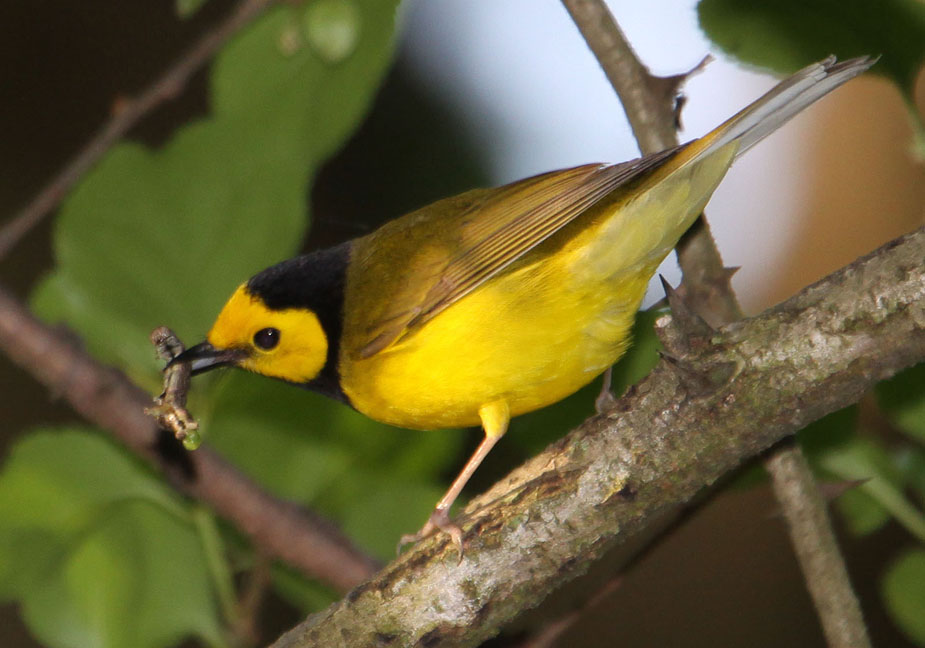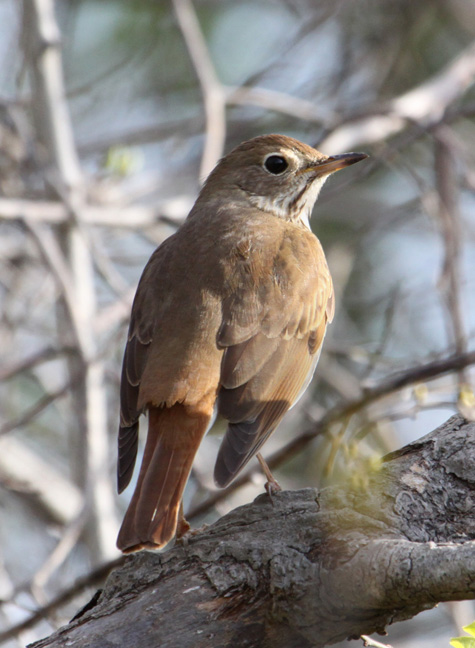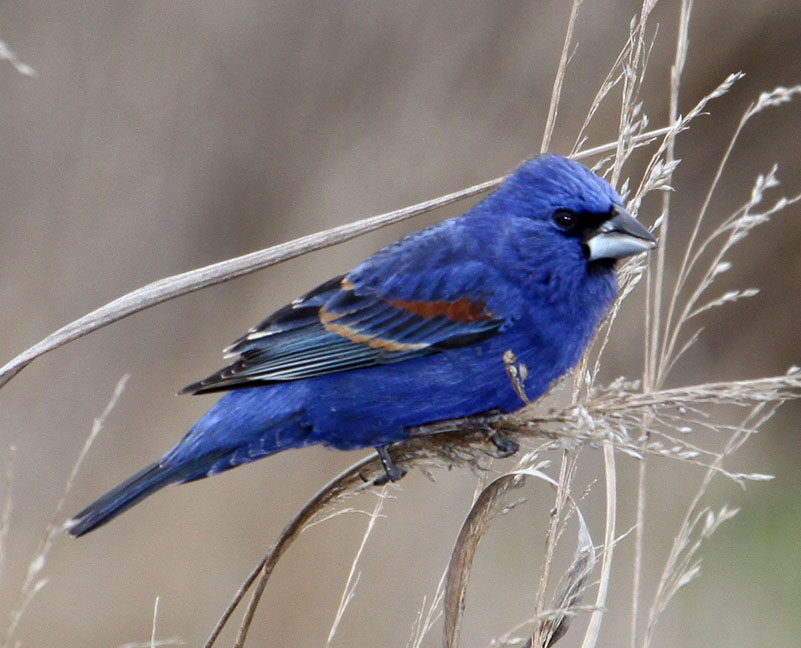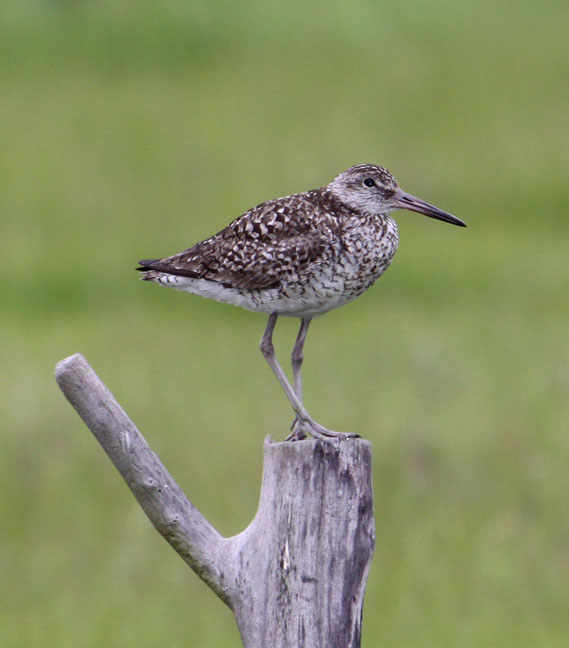Advanced Quiz #1
Advanced identification
This is an advanced quiz designed for more experienced birders. The birds included here can be easily confused with other species, or are species that are not encountered often. If you do not score well in this quiz, don't be discouraged, but instead try the quizzes at an easier level and work your way up. If this quiz is too easy, new 'No clues' quizzes will be coming soon.
Start
Question 1 |
A | Canada Warbler Hint: The upper body of the Canada Warbler is gray. |
B | Hooded Warbler Hint: Yes. A moslty yellow warbler with a black hood and masks surrounding a yellow face patch is a Hooded Warbler. |
C | Common Yellowthroat Hint: Common Yellowthroat has a black face mask and less yellow on the body. |
D | Kentucky Warbler Hint: Kentucky Warbler does not have a black hood. |
E | Wilson's Warbler Hint: Wilson's Warbler is mostly yellow, but just having a black cap. |
Question 2 |
A | American Kestrel Hint: Yes. A female American Kestrel, based on the barred tail and the lack of bluish wings seen in males. |
B | Prairie Falcon Hint: Prairie Falcon lacks the bright rufous back of this bird. |
C | Merlin Hint: Merlin has a dull brown or dark gray back, not the bright rufous of this bird. |
D | Aplomado Falcon Hint: Aplomado Falcon has a dark gray back, not the bright rufous of this bird. |
E | Peregrine Falcon Hint: Peregrine Falcon has a dark gray back, not the bright rufous of this bird. |
Question 3 |
A | Veery Hint: Veery has a rufous back and wings, not just the rufous tail, and lacks the clear eye-ring of this bird. |
B | Swainson's Thrush Hint: Swainson's Thrush has buffy throat and spectacles. |
C | Ovenbird Hint: The bill is too long for ovenbird. |
D | Gray-cheeked Thrush Hint: Gray-cheeked Thrush has a buffy throat and lacks the distinctive rufous tail of this bird. |
E | Hermit Thrush Hint: Yes. The bill is correct for a thrush, and the rufous tail is indicative of Hermit Thrush. |
Question 4 |
A | Cerulean Warbler Hint: The bill is too long for a warbler. |
B | Cinereous Conebill Hint: Conebills have never been seen in the US. |
C | Black-throated Blue Warbler Hint: The bill is too long for a warbler. |
D | Eastern Bluebird Hint: Bluebird has a bluer back, white belly, and a differently shaped bill. |
E | Red-breasted Nuthatch Hint: Yes. The bold white supercilium, black eye-line, rusty breast, short tail, and distinctive nuthatch bill all point to Red-breasted Nuthatch. |
Question 5 |
A | Double-crested Cormorant Hint: Cormorants have hooked tips to their bills. |
B | Neotropic Cormorant Hint: Cormorants have hooked tips to their bills. |
C | Pelagic Cormorant Hint: Cormorants have hooked tips to their bills. |
D | Anhingha Hint: Yes. The long neck and needle-like bill are unmistakeable. |
E | Green Heron Hint: Try again. |
Question 6 |
A | Yellow-headed Blackbird Hint: Try again. |
B | Blue-winged Warbler Hint: Yes. The bluish wings with two prominent wing bars, combined with extensive yellow on the face and belly, points to Blue-winged Warbler. |
C | Golden-cheeked Warbler Hint: Golden-cheeked Warbler has a limited range in Texas, has a black throat, cap, and back. |
D | Orchard Oriole Hint: The tail of the female Orchard Oriole is yellow. Orchard Oriole is significantly larger than the bird shown here. |
E | Yellow-green Vireo Hint: No. Yellow-green Vireo does not have wing bars. |
Question 7 |
A | Purple Gallinule Hint: Purple Gallinule would have a more brilliant purple color on the belly and neck. |
B | Black Rail Hint: compared to this bird, with a small dark bill. |
C | Common Gallinule Hint: Yes. Until recently called Common Moorhen. The white line on its flank is one clue that separates it from Purple Gallinule in this view.. |
D | American Coot Hint: Coot has a white bill, not mostly red. |
E | Sora Hint: Sora is not uniform gray like this bird, and has a yellow bill with a black face mask. |
Question 8 |
A | Black-backed Woodpecker Hint: This bird doesn't have a black back. |
B | American Three-toed Woodpecker Hint: Very good. The unmarked black wings, barred back and yellow crown indicate a male American Three-toed Woodpecker. |
C | Downy Woodpecker Hint: Downy has white spots on the wings and a white back. |
D | Red-cockaded Woodpecker Hint: Red Cockaded Woodpecker has a sizeable white cheek patch that is not seen on this bird. |
E | Ladder-backed Woodpecker Hint: Ladder-backed Woodpecker has extensively barred back and wings. |
Question 9 |
A | Mountain Bluebird Hint: Mountain Bluebird has unmarked wings, lacks the black face mask, and has a much smaller bill than this bird. |
B | Eastern Bluebird Hint: Bluebird has a white belly and extensive orange breast. |
C | Indigo Bunting Hint: Indigo Bunting does not have wing bars and has a smaller bill. |
D | Lazuli Bunting Hint: Lazuli Bunting has a white belly and orange breast. |
E | Blue Grosbeak Hint: Yes. the rusty wing bar, overall blue color and thick bill are indicative of Blue Grosbeak. |
Question 10 |
A | Pygmy Nuthatch Hint: Very close. |
B | Boreal Nuthatch Hint: There is no such bird. Try again. |
C | Brown-headed Nuthatch Hint: Yes. The bright brown head and white patch on back of the nape are indicative. |
D | White-breasted Nuthatch Hint: White-breasted Nuthatch has a black crown and steely gray back and wings. |
E | Brown Creeper Hint: Brown creeper is overall a mottled brown bird with a downcurved bill. |
Question 11 |
A | Hudsonian Godwit Hint: Hudsonian Godwit has a black tail and different overall color pattern that changes depending on the time of year. |
B | Marbled Godwit Hint: Yes. The long and slightly upturned bill indicates Godwit, and the banded tail and mottled buffy color points to Marbled Godwit. |
C | Whimbrel Hint: Whimbrel has a strongly downcurved bill |
D | Long-billed Curlew Hint: Although our bird has a long bill, a Long-billed Curlew actually has a longer bill (!!) that is downcurved, not upturned. |
E | Willet Hint: Willet is a fairly non-descript gray bird,with a bill that is long, but shorter and straighter than our quiz subject. |
Question 12 |
A | Blue-headed Tanager Hint: Blue-headed tanager would never be seen in the US. It has a lighter blue head and no red in its plumage. |
B | Painted Bunting Hint: Yes. An unmistakable male. |
C | Rainbow Tanager Hint: There is no such bird. |
D | Crimson-throated Tanager Hint: Sorry, but there is no such bird. |
E | Pyrrhuloxia Hint: Bad guess. Pyrrhuloxia is cardinal-like without this range of colors. |
Question 13 |
A | Black-billed Magpie Hint: Yes. Unmistakable black and white pattern with long tail and large bill. |
B | Clark's Nutcracker Hint: Try again. Clark's Nutcracker is mostly gray. |
C | Northwestern Crow Hint: A crow would be all-black |
D | Pied Cowbird Hint: There is no such bird as a Pied Cowbird. |
E | American Raven Hint: A raven would be all-black |
Question 14 |
A | Mountain Chickadee Hint: Very good. The white supercillium distinguishes it from other chickadees. |
B | Black-capped Chickadee Hint: Black-capped Chickadee does not have the white supercillium. |
C | Boreal Chickadee Hint: Boreal Chickadee has a dark brown cap and lighter brown flanks. |
D | Black-throated Gray Warbler Hint: Black-throated Gray Warbler has lateral black stripes on its flanks and a yellow spot in front of its eyes. |
E | Mexican Chickadee Hint: Mexican Chickadee does not have the white supercillium and has dark gray flanks. |
Question 15 |
A | Northern Shrike Hint: Northern Shrike has a back face mask. |
B | Townsend's Solitaire Hint: Very good. A plain gray bird with an obvious eye-ring and buffy wing patches is a Townsend's Solitaire. |
C | Northern Mockingbird Hint: Northern Mockingbird has white wing patches and lack the white eye-ring of this bird. |
D | Clark's Nutcracker Hint: Clark's Nutcracker has black wings and a much longer bill. |
E | Gray Catbird Hint: Gray Catbird is more uniform dark gray and does not have the eye ring or the wing patches of this bird. |
Question 16 |
A | Dunlin Hint: The bill is far too long for Dunlin. |
B | Whimbrel Hint: Whimbrel has a longer downcurved bill |
C | Willet Hint: Yes. This is an eastern Willet in breeding plumage. The gray legs and long straight bill are indicative of Willet. |
D | American Golden-Plover Hint: The bill is WAY too long for a plover. |
E | Marbled Godwit Hint: Marbled Godwit has a buffier color and longer upturned bill. |
Question 17 |
A | Blue Grosbeak Hint: Blue Grosbeak is darker blue, has a larger bill, and rufous wing bars. |
B | Field Sparrow Hint: Although our bird looks sparrow-like, a Field Sparrow is mostly brown. |
C | Indigo Bunting Hint: Yes. This bright blue male is typically found around brushy areas or edges of fields. |
D | Eastern Bluebird Hint: Eastern Bluebird has an orange throat and chest. |
E | Lazuli Bunting Hint: Although its mostly blue, a Lazuli Bunting has an orange chest, white belly, and white wing bars. |
Question 18 |
A | American Tree Sparrow Hint: American Tree Sparrow has a rusty cap, but has a bi-colored bill, mostly gray face, and a rufous eye-line. |
B | Rufous-capped Sparrow Hint: There is no such bird as a Rufous-capped sparrow. On the advanced quizzes the possible answers occasionally will be tricky. |
C | American Pipit Hint: Pipits have much pointier bills. |
D | Chipping Sparrow Hint: Well done. The rufous crown and black eye stripe are indicative. |
E | Song Sparrow Hint: Among other differences, a Song Sparrow would have stripes on its chest. |
Question 19 |
A | American Tree Sparrow Hint: American Tree Sparrow has a rusty crown and a rufous eye stripe, but has a clearly bi-colored bill. |
B | Field Sparrow Hint: Yes. The pink bill, rusty crown and mostly gray face is diagnostic for Field Sparrow. |
C | House Sparrow Hint: Male House Sparrow has a black throat and lacks the rusty cap seen here.. |
D | Swamp Sparrow Hint: Swamp Sparrow has a darker gray breast with weak streaks and a mostly dark gray face. |
E | Clay-colored Sparrow Hint: Clay-colored Sparrow is overall buffier, with a strong lateral white throat patch and eye line that highlight its ear patch. |
Question 20 |
A | Sandhill Crane Hint: No Sandhill Cranes are nearly uniform gray as adults. |
B | Little Blue Heron Hint: Little Blue Heron has a uniform blue color as adults. |
C | American Bittern Hint: American Bittern is mostly brown with a shorter neck. |
D | Great Blue Heron Hint: Great Blue Heron does not have the white belly of this bird. |
E | Tri-colored Heron Hint: Yes. The white belly and front of the neck is diagnostic for a Tri-colored Heron. |
There are 20 questions to complete.
← |
→ |
You have completed
questions
question
Your score is
Correct
Wrong
Partial-Credit
You have not finished your quiz. If you leave this page, your progress will be lost.
Correct Answer
You Selected
Not Attempted
Final Score on Quiz
Attempted Questions Correct
Attempted Questions Wrong
Questions Not Attempted
Total Questions on Quiz
Question Details
Results
Date
Score
Hint
Time allowed
minutes
seconds
Time used
Answer Choice(s) Selected
Question Text
All done
Need more practice!
Keep trying!
Not bad!
Good work!
Perfect!



















